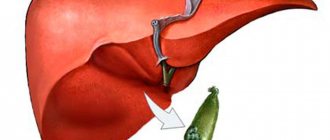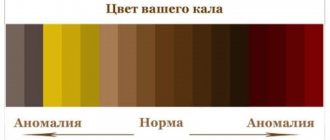Depending on age, the frequency of bowel movements, consistency and color of stool are different. In infants, the frequency of bowel movements can be up to 7-8 times a day and up to 1 time every 2-4 days, and this is the norm. In children of the 2nd year of life, the number of bowel movements is 1-2 times a day. The stool should be well-formed and of soft consistency, the number of bowel movements is determined by the child’s individual rhythm - the baby is healthy and there is no need to worry.
If the baby's stool is liquid or looks like "sheep" feces, it is advisable to consult a pediatrician and examine the child as planned.
The color of the stool may vary, mainly depending on what foods the child eats. But if the baby’s stool has become black and sticky, it may be bleeding (stomach or intestinal); if it has become colorless, it may be a liver or gallbladder disease.
URGENT CARE
Call an ambulance if:
- The child's stool has become black and sticky
- a child's stool is profusely mixed with scarlet blood (bleeding from the lower gastrointestinal tract, mainly the large intestine)
THE DOCTOR'S CONSULTATION
Contact your pediatrician if:
- the skin and mucous membranes turn yellow and the stool is discolored
- the child's stool is large, greasy and has an unpleasant odor (a sign of poor digestion)
ATTENTION!
If the stool is copious, greasy, or foul-smelling, this is a sign of poor digestion. A doctor's consultation is required .
| ASK YOURSELF A QUESTION | POSSIBLE REASON | WHAT TO DO |
| The general condition is good, there is a tendency to constipation, the child has pain when defecating, and a few minutes later there is blood on the toilet paper and a little in the stool | Anal fissure | Consultation with a pediatrician for examination and examination |
| Change in stool after taking medications (antibiotics), becoming more liquid | Side effects of drugs | Consultation with a doctor to discontinue the medication or reduce the dose and course of treatment |
| The child feels well but has dark-colored stools (is taking iron supplements, or has eaten blueberries or dark green vegetables) | Effect of medications or food on stool | The baby is fine, no need to worry |
| The baby's stools have become clayey and light in color, his urine has darkened, his skin has a yellowish tint, and his sclera (the whites of his eyes) have turned yellow. | Viral hepatitis (older children) Congenital liver disease or biliary atresia (newborns) | Call your pediatrician immediately, for examination and treatment, the child may be hospitalized. Before the doctor arrives, keep the baby calm. |
| The stool is faintly colored, smells unpleasant, is greasy and profuse | Insufficient digestion | Consultation with a pediatrician (or gastroenterologist ) for examination and treatment prescription |
| An increase in temperature, a violation of the general condition, an admixture of dark burgundy or scarlet blood in the stool | Inflammatory diseases of the gastrointestinal tract, bleeding from different parts of the intestine | Call emergency services immediately ; hospitalization for examination and treatment is possible. |
| Stools resemble coffee grounds or are black and sticky | Bleeding from the upper gastrointestinal tract (esophagus or stomach), called melena | Call emergency services immediately ; hospitalization for examination and treatment is possible. |
FOR INFORMATION
Stool color and consistency
The color and consistency of your child's stool may change from time to time - this is normal. However, traces of fresh blood or black, sticky stools may be signs of bleeding and require urgent evaluation. The sudden appearance of loose stools, with or without mucus, indicates diarrhea. If the stool is copious, greasy, smells bad, and is faintly colored, these are signs of poor digestion of food. In all these cases, an examination by a pediatrician is required. If your child's stool is light, clay-colored and his urine has become dark, viral hepatitis is possible - call your pediatrician immediately .
Minor changes in stool color are related to diet. In breastfed children, the stool is soft, almost liquid, reminiscent of light mustard. It may contain particles that look like seeds. With artificial feeding, the stool is yellowish-brown or yellow, denser, but still no denser than putty. If the stool is very hard and dry, this may be due to a lack of fluid or excess fluid loss, for example, with sweat due to an increase in temperature, etc. If the child has eaten a large portion of vegetables or other difficult-to-digest foods, digestion may slow down and the stool may be very dark colors. Beetroot or red-colored foods may cause your stool to become reddish (for the same reason, your urine may turn pink).
The stool turns blue, purple, or another shade if the child tastes crayons. In this case, as soon as the colored substance is released from the intestines, the stool returns to its normal color. If the child's condition worsens, call the pediatrician immediately - poisoning is possible.
What parents need to know
Streaks of blood or clots in small quantities may be observed in the stool itself, color the stool black, or may be released during the act of defecation. To make a correct diagnosis, the doctor will need to ask in detail about the problem.
Parents need to know:
- How long ago did the blood appear?
- how often is it observed;
- how much of it is contained in feces;
- what color is it (red, burgundy);
- in what form they are present in feces (veins, clots);
- Are there any other alarming phenomena: mucus resembling snot, foam;
- character of stool: loose stools or constipation;
- How does the baby feel?
By the color and composition of the blood discharge, you can determine in which parts of the intestine the bleeding is occurring. If violations occurred in the lower sections, then the blood streaks will be scarlet. Black poop indicates problems in the upper intestines.
Immediately after birth, the baby passes the original stool (meconium). It has black color. Normally, it should no longer be there on the 4th day. If meconium appears again after 2 weeks, you should consult a doctor.
Such a disorder can be observed in diseases such as jaundice, hemorrhagic disease, and sepsis.
Stool consistency and frequency
Norm
In infants, stools are more frequent and softer. With the introduction of complementary foods, the frequency and consistency of stools change significantly, becoming denser.
Peculiarities
- The consistency and frequency of a baby's stool depends very much on the type of feeding.
- A breastfed baby's stool is mushy, homogeneous, and the frequency is equal to feedings. The frequency of stools also decreases in breastfed children with the introduction of complementary foods.
- A bottle-fed baby's stool is much denser (pasty), but not yet formed like an adult's. The density of stool is closely related to its frequency. Those who have artificial stools have less frequent stools - perhaps up to once a day, sometimes up to once every two days; they are more often bothered by constipation. The problem of increased stool density requires more attention from the pediatrician, and sometimes nutritional correction.
- The stool becomes less frequent and denser with the appearance and increase in the volume of complementary foods and becomes formed in a child who eats from the common table - your baby has grown up!
Important!
- Dense, rare (less than 2 times a week), large-diameter stools are diagnostic signs of constipation. Constipation is not always accompanied by pain, and therefore a small part of parents turn to the pediatrician immediately.
- The specialist’s recommendations may relate to the nutrition of the child and/or mother, but it is possible to prescribe laxatives in this case - there are children’s medications, you should not be afraid of them.
- Try to do without frequent interventions in the “life of the rectum” - therapeutic enemas and suppositories. There is a ready-made complex rectal preparation (a special form for children), it is used in addition to laxatives if their effect is insufficient.
Alarming symptoms, you should immediately contact your pediatrician!
- Viral and bacterial infections. Loose and frequent (10 or more times per day) stools. The most common cause of this condition is viral and bacterial intestinal. The danger of loose stool is the very rapid dehydration of a small child. In this case, independent or late treatment is unacceptable!
- Lactase deficiency (lack of enzyme in the child’s intestines that digests milk sugar, lactose). In this case, loose stools are a) associated with feeding, b) have a foamy appearance and c) are accompanied by pronounced anxiety of the child. In most cases, the baby will “outgrow” this problem in the first six months of life, and the pediatrician will help cope with temporary difficulties by prescribing lactase medications.
- Poisoning, taking medications (usually antibiotics), and other digestive diseases can also cause loose stools, so you shouldn’t figure out the reasons on your own. Time is precious in this case.
Cases when you don't have to worry
Stool in healthy newborn babies is light brown in color and has a mushy consistency. A child's poop may change its normal color due to the following reasons.
- Nutrition for a nursing mother. Some foods affect the color of stool. For example, beets, tomatoes. Red veins appear.
- Taking medications: antibiotics, drugs containing iron, activated carbon.
- First complementary foods.
If, after changing your diet and stopping medications, your poop also has blood in it, you should consult a doctor.
When you don't need to worry
Blood in a baby's stool does not always indicate health problems.
Blood streaks in the stool of a breastfed baby do not always indicate pathological changes in the body. Normally, newborn feces have the consistency of porridge and are light yellow or brown in color. Stool may change color for physiological reasons:
- maternal nutrition - if a woman eats tomatoes, green vegetables and fruits, beets, carrots, chocolate products, then the stool of a breastfed baby becomes dark;
- treatment with antibiotics, iron preparations and activated carbon, products with food coloring;
- introduction of additional products into the infant’s diet;
- teething in the baby and cracks in the nipples in the mother when breastfeeding - minor bloody discharge, swallowed by the baby, then appears in the feces.
Also, a change in the appearance of feces occurs as a result of feeding formula-fed newborns with formula - streaks of blood in the feces of a baby appear due to a restructuring of the digestive system and are not considered pathological.
Why does a violation occur?
The problem can occur in both bottle-fed and breast-fed babies. If streaks of blood or mucus resembling snot are found in the stool, this may be a symptom of certain diseases. The following reasons can be identified.
- Wounds and fissures of the anus in a child. Streaks of blood begin to appear as a result of frequent constipation.
- Sores in the nipple area of the mother. When breastfeeding, the baby may swallow blood along with the milk.
- Signs of atopic dermatitis. The intestinal mucosa becomes affected by a rash that begins to bleed.
- Dysbacteriosis. Mucus appears, like snot, and red streaks of blood.
- Allergic reaction to cow's milk protein. In this case, in addition to stool disturbances, vomiting is observed. Such protein can enter the body along with the mixture. If a baby is breastfed, protein from the mother's diet will pass into breast milk and then into the baby's body. Peeling of the skin, rash, and redness may occur. The child eats poorly and gains little weight. This condition leads to anemia.
- Inflammatory bowel diseases (eg, colitis). Blood clots do not mix with stool. Loose stools, mucus like snot, vomiting, and loss of appetite are observed. The child is not gaining weight well.
- Intestinal infection. There is a high body temperature, vomiting, loose stools and mucus, like snot, and loss of appetite.
- Pathologies of various parts of the intestine. The condition may be accompanied by high fever, lethargy, loss of appetite, and abdominal pain. There is an admixture of mucus and streaks of blood.
- Lack of vitamin K, which is responsible for blood clotting.
- Helminthiasis. Infection with worms occurs in utero or during childbirth. In addition to blood in the stool and mucus like snot, there is a rash on the body and weight loss.
- Polyps in the intestines are accompanied by bleeding. Sometimes blood is not clearly present in the stool. It can be detected during testing (reaction to occult blood).
- Lactose deficiency. The child’s body lacks the enzyme lactase. The poop contains blood, mucus that resembles snot, and lumps of undigested milk. The child is crying, capricious, lethargic, and eating poorly.
You should contact emergency doctors in the following cases:
- diarrhea, mucus (looks like snot) and blood;
- the child vomits;
- body temperature rises sharply;
- pain in the abdomen (the child cries, bends his legs to his tummy).
The reasons for the appearance of stool streaked with blood may be the following:
- Cracks and abrasions in the anal area. Frequent constipation can lead to this problem. The child groans and experiences pain during bowel movements. In these cases, it is enough just to adjust the power supply, and the problem disappears.
- The effect of the allergen on the intestinal mucosa. As a result, it becomes swollen, inflamed, and the stool contains streaks of blood.
- Polyps in the intestines.
- Obstruction of various parts of the intestine.
Reasons for the appearance of blood clots in the stool: internal hemorrhoids, intestinal dysbiosis, colonization of parasites (enterobiasis, ascariasis).
When a child has loose black stools, you should urgently call an ambulance. The condition indicates severe internal bleeding in one of the sections of the digestive tract. The reasons may be the following: stomach ulcer, varicose veins of the digestive system.
Blood in a child's stool: causes and diagnosis
Authors : Shcherbina E. A.
(The article has been translated and adapted specifically for the ClubCom website. Source: “UpToDate”)
INTRODUCTION
Finding blood in a child's stool can be very alarming for parents. However, this happens quite often and in the vast majority of cases is not dangerous. There are many known causes of rectal bleeding, but they mostly depend on the age of the child. Your doctor will help you determine why this is happening and choose the most appropriate treatment.
In this article, we'll look at some of the most common causes of rectal bleeding (blood in the stool) and describe additional tests that may be needed for diagnosis.
WHEN TO SEEK HELP
Most children with mild rectal bleeding do not have serious illnesses. However, it is impossible to determine the true cause of bleeding in absentia. Therefore, if you notice that your child is bleeding from the rectum, you should take him to the doctor to determine whether further testing is needed.
TYPES OF RECTAL BLEEDING
There are two main sources of blood in stool: the upper digestive tract (stomach and small intestine) and the lower digestive tract (colon, rectum and anus).
- Bleeding from the upper digestive tract usually causes black, tarry stools (this is due to the conversion of iron in hemoglobin to hematin hydrochloride by the action of stomach hydrochloric acid. Hematin hydrochloride is black in color).
- Bleeding from the lower digestive tract is usually caused by stool that is characterized by stool containing fresh blood that is red in color (streaks of blood or blood mixed with stool).
- Some foods and medications can also change the color of stool, making it almost the color of blood (i.e., red or black). A list of these substances is given below:
- antibiotics; - beet; - Activated carbon; - flavored gelatin (red); — powder dyes with drinks; - medications that contain dyes; - chocolate; - iron supplements; - various dark green foods.
However, it is not always possible to accurately determine the source or type of rectal bleeding based solely on the color of the stool. Questioning and inspection are necessary in any case.
MAIN CAUSES OF BLOOD IN THE FECTOR
- An anal fissure, or anal fissure, is a tear in the mucous membrane that can develop if a child constantly has large and/or hard stool (constipation). Anal fissures can occur in children of all age groups - from newborns to school-aged children and even students. Symptoms of an anal fissure include pain, straining, crying or grunting during bowel movements, and bright red (fresh) blood on the surface of the stool. Many infants and children with anal fissures have a history of constipation.
- Cow's milk protein and soy allergy (CMPA) is an intolerance to cow's milk and soy, also known as "milk allergy", "protein-induced proctitis or proctocolitis". This condition is usually diagnosed in infants. This pathology is associated with sensitization of the child’s body to cow’s milk or soy protein and usually develops in bottle-fed children. But allergies can also develop in a breastfed baby if his mother consumes dairy products. In most cases, ABCM goes away without treatment by 12 months, that is, the child outgrows it. Symptoms of ABCM may include vomiting, diarrhea, and blood in the stool. If it is ABCM that is recognized as the most likely cause of blood in the stool, then a diet excluding cow's milk is considered the tactic of choice. They are trying to switch formula-fed children to formulas containing split cow's milk protein. Mothers who are exclusively breastfeeding are asked to eliminate all dairy products from their diet for approximately 2 weeks, after which they can try to evaluate the effectiveness of this “therapy”.
LESS COMMON CAUSES
- Inflammatory bowel disease, also known as Crohn's disease or ulcerative colitis, is a condition that affects the lining of the gastrointestinal tract. Inflammation leads to symptoms such as bloody stools, diarrhea, lack of appetite and weight loss.
- Infectious diarrhea caused by viruses, bacteria or parasites, which may be accompanied by the appearance of blood in the stool in preschool and school-age children. Infectious diarrhea can develop as a result of consuming contaminated foods or drinks, or after taking a course of antibiotics (referred to as “antibiotic-associated diarrhea”). The most typical symptoms of infectious diarrhea are blood in the stool, fever, and abdominal pain.
- Juvenile polyps are growths on the lining of the colon that can develop in children between the ages of two and eight. They usually present with asymptomatic bleeding of fresh blood. Juvenile polyps are usually benign or precancerous, but the doctor must examine the child to decide whether to remove them.
- A number of other, more serious conditions, including intussusception (a form of intestinal obstruction) or Hirschsprung's disease (a form of obstruction of the large intestine that occurs at birth), can also cause rectal bleeding. In most cases, all these conditions develop suddenly. If your child suddenly becomes lethargic, has bloody stools, abdominal pain, fever or other unusual symptoms, contact your doctor immediately!
DIAGNOSIS OF ANAL BLEEDING (LABORATORY AND INSTRUMENTAL METHODS)
Sometimes a doctor can determine the cause of bleeding only through information gathering and a physical examination, which usually includes a digital examination of the anus, or in other words, a rectal examination. The doctor may also test a stool sample for blood using laboratory tests.
Usually, the use of these two research methods is sufficient for diagnosis. If the cause of bleeding remains unclear, then a more in-depth examination may be required. It includes colonoscopy, an endoscopic examination of the large intestine, and imaging tests (X-rays or ultrasounds). The doctor chooses the most appropriate methods depending on the clinical picture of the disease.
TREATMENT OF RECTAL BLEEDING
As mentioned above, there are a number of possible causes of rectal bleeding. But only the attending physician can decide whether your child needs treatment and what exactly it will consist of. Even if the bleeding seems minor or goes away on its own, your child should be examined by a doctor!
Page of Shcherbina E.A. in ClubCom
published 07/20/2015 12:00 updated 02/18/2022 - Diseases of the gastrointestinal tract, Popular medicine
What measures need to be taken
Dangerous symptoms that are accompanied by the appearance of blood in the stool of an infant are: high body temperature, frequent vomiting, diarrhea, pale skin. In these cases, you should definitely contact a specialist.
Self-medication can lead to worsening of the condition and irreversible consequences. You may need to consult an allergist, gastroenterologist, or hematologist.
Additional examination methods will be prescribed:
- Ultrasound of the abdominal cavity.
- Analysis of stool for dysbacteriosis.
- The most effective method is coprogram. According to its data, in most cases it is possible to determine the cause of bleeding.
- General blood and urine analysis.
- Intestinal biopsy. A small piece of the small intestinal mucosa is taken. The procedure is performed under anesthesia.
- Fibrogastroduodenoscopy.
Treatment
If, while breastfeeding, the baby develops blood streaks in the stool, therapy depends on the cause that provoked the syndrome. To make it easier for the doctor to make a correct diagnosis, it is better to save some of the newborn’s stool and show it or take a photograph where bloody spots are visible in the stool. Before prescribing any treatment, you will have to undergo the necessary examinations, which are described below.
Diagnostics and tests
To exclude less dangerous diseases during breastfeeding, such as dysbiosis, helminthiasis and ingestion of blood due to cracks in the mother’s nipples, an analysis is performed for dysbiosis, worm eggs and the Apta-Downer test. The latter technique allows you to distinguish blood in the stool that belongs to the baby from the mother’s ichor. To do this, the required part is isolated from the baby’s feces and mixed with a sodium hydroxide solution in a centrifuge. If the mixture turns brown, the blood belongs to the mother, her hemoglobin is present; the preservation of the pink color indicates the presence of the child’s hemoglobin. Blood and urine are also taken for general analysis.
Research methods are as follows:
- Coprogram. To make a diagnosis, the presence in the stool, in addition to blood, of mucous inclusions, undigested breast milk, and remnants of red blood cells is determined. The method is fundamental in the diagnosis of intestinal diseases.
- Coagulogram. It is carried out to confirm or refute bleeding disorders. Prothrombin and thrombin time, fibrinogen are determined.
- Gregersen reaction. Before donating blood, the baby is not fed meat if he is mixed-fed. Allows you to determine hidden blood that is not observed in the stool.
- Tests for lactase deficiency. It is determined how many carbohydrates are contained in the child’s feces, hydrogen in the air exhaled by the baby after lactose has entered the body (breath test), and the process of absorption of D-xylose is assessed.
Additional hardware and laboratory testing techniques depend on the preliminary diagnosis. So, if intestinal obstruction is suspected, an x-ray with a contrast agent is performed.
Treatment methods
The principles of treatment for bloody streaks in the stool depend on the cause that caused the appearance of the alarming sign:
- frequent constipation, leading to cracks in the intestinal and anal mucosa, can be eliminated by adjusting the mother’s diet if the newborn is breastfed and by revising complementary foods with mixed feeding;
- intestinal obstruction is treated surgically, the doctor performs manual straightening of the intussusception;
- therapy for intestinal infections is based on rehydration and antibiotics;
- an allergy to cow's milk is eliminated by replacing it with a highly adaptive hypoallergenic formula, and when breastfeeding, by correcting the mother's diet;
- lactase deficiency is treated by administering lactose-free baby food to the baby - Nutrilon, Humana, Enfamil;
- treatment of hemorrhagic disease is carried out by introducing into the body a synthetic analogue of vitamin K - the drug Vikasol;
- rectal polyps, including juvenile ones, are assessed in terms of size and danger to the baby’s health - the decision on the need for removal is made by the doctor;
- helminthic infestations are treated by taking antiparasitic drugs in children's dosages, maintaining hygiene and limiting contact with the source of infection (it is necessary to deworm pets, boil bed linen, and disinfect the premises).
These are the treatment methods necessary for the appearance of bloody streaks in the stool of infants. Additional medications and methods will be prescribed by the attending physician, depending on the provoking factor.
If it is not possible to immediately determine the cause of the appearance of blood in the baby’s stool, it is better not to refuse hospitalization. In a hospital setting, mothers will be helped to establish the feeding process, monitor the child’s condition, and carry out a wide range of diagnostic procedures. This applies to situations where blood in the stool is accompanied by insufficient weight gain in the infant, poor sleep and appetite, and signs of abdominal pain. Even in the absence of danger symptoms, bloody spots in the baby’s stool should not go unnoticed by parents and pediatricians.
What can a coprogram tell you?
Sometimes occult blood is detected in stool tests. A positive reaction to blood becomes a consequence of such serious diseases as cancer of the digestive organs, stomach ulcers, intestinal tuberculosis, and typhoid fever.
A positive reaction to blood is not detected by macroscopic examination. Diagnostic strips are used for this.
Reaction to bilirubin. It can be detected in a baby's stool for up to 3 months. A positive reaction in infants older than 3 months can occur when food passes through the intestines too quickly, or in cases of severe dysbiosis.
Reaction to stercobilin (urobilinogen). This is the end result of the breakdown of hemoglobin in the intestines. A decrease in stercobilinogen indicates liver disease. An increase indicates hemolytic anemia.
Reaction to leukocytes. Their appearance indicates inflammatory processes in the colon.
Stool that contains snot-like mucus may be a sign of:
- dysbacteriosis or lactose deficiency;
- poor mother’s diet (fried, spicy foods);
- intestinal infection;
- respiratory viral diseases (snot, cough).
Therapeutic measures
In some cases, in order for stool to improve, it is enough just to adjust your diet and lifestyle.
- Stopping all medications.
- Avoiding foods that can turn poop red.
- Intestinal obstruction is treated with surgery.
- Intestinal infection is treated with antiviral drugs, antibiotics and antimicrobial drugs.
- If a child suffers from constipation, the diet should be changed. It is possible to use laxatives (Duphalac, Normaze).
If alarming symptoms appear in a child, parents do not need to panic, even if the child requires hospital treatment. The infant should be closely monitored to ensure the problem is described in detail. This will help make a more accurate diagnosis. You cannot use traditional medicine methods on your own, much less give medications. The condition may worsen and cause complications.










